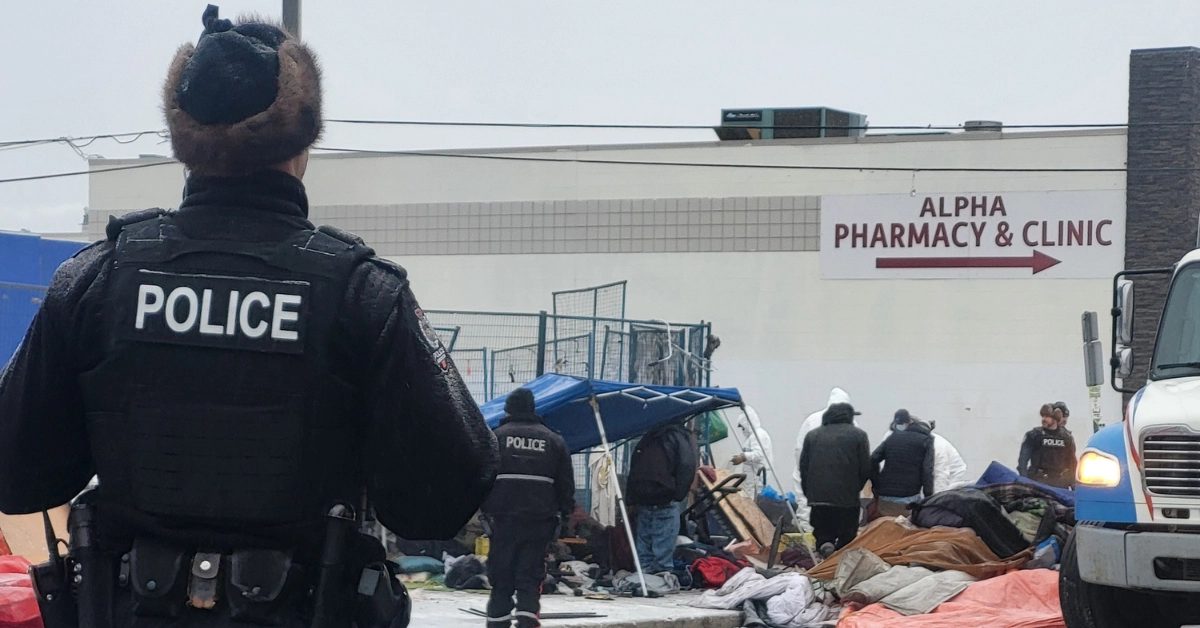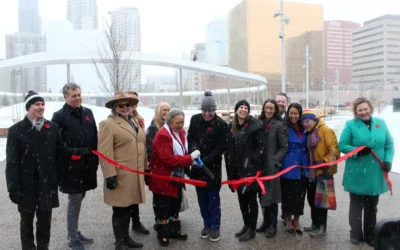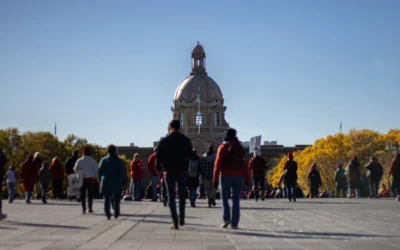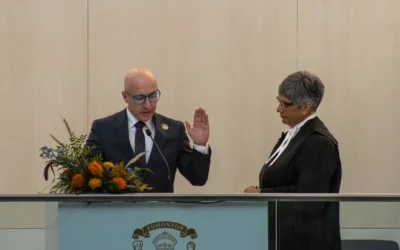Close your eyes for a moment and imagine the following: you have fallen on hard times and have now lost everything — your job, education, housing, and your family and friend’s support. Where and who do you turn to? Perhaps a homeless shelter for the night or a forest in the River Valley? Perhaps you’ll go to one of the public libraries or find a group who have banded together to create a community — an encampment.
This isn’t just a thought experiment — it’s a reality for many people in Edmonton.
This month, Edmonton Police Service (EPS) conducted encampment sweeps across the city at sites that were deemed “high risk.” The Edmonton Journal even describes how dangerous encampments are to citizens due to violence, gang activity, and illicit use of propane tanks. The language in the article implies that EPS sweeps are necessary.
“I think it’s blown out of proportion, really. I think, you know, there’s talks about gangs being there — well, there’s gangs everywhere. There’s talks about people using propane tanks. Well, they don’t have ways to heat their tents or cook their food,” says Brandon Shaw, a person with lived experience in an Edmonton encampment.
“When we don’t have those supports in place, those are necessary evils,” says Shaw. “Unless we’re really willing to do what it takes to provide people with the necessary, like, supportive spaces where gangs don’t need to be there, then we’re always going to be dealing with it.”
Shaw has found secure housing and is now an active member of the harm reduction community. When asked why he chose to live in an encampment rather than in a shelter, Brandon says, “I felt safe in encampments. I’m not told what to do unfairly like I would in a shelter. I could build my own community.”
“Unless we’re really willing to do what it takes to provide people with the necessary, like, supportive spaces where gangs don’t need to be there, then we’re always going to be dealing with it.”
Brandon Shaw, harm reduction community member
On Jan. 6, I witnessed a sweep of the Hope Mission encampment in the downtown core. When I arrived, I immediately noted several non-profit organizations that were ready to provide aid with coffee, snacks, supplies and support.
Although Edmonton is a small city, the harm reduction community is even smaller. EPS blocked off a section of the street so that city employees could operate. One community member limped towards an aid station, wearing a garbage bag on her right foot and a flip-flop on her left. I couldn’t help but wonder about what would happen to her once the temperature plummets.
While police officers remained mostly silent during the sweep, there were instances when community members asked them questions. One person asked, “Why is it that there are million-dollar buildings being built while we’re stuck in the streets?” The EPS officer suggested that they move to a homeless shelter.
“Who is this helping? Is it helping the people in the neighbourhood? Is it helping the city? Is it helping the houseless population? They’re saying it’s -40 C out. This is what we are doing, and you are going to see more of it.”
Nooreen, third-year MacEwan social worker student
“We’re all aware of it; we just don’t know what to do about it. It’s like, okay, what happens after?” says Nooreen, a third-year social work student at MacEwan. “It’s sad because it’s not giving context to why they are doing encampment sweeps.”
“Who is this helping? Is it helping the people in the neighbourhood? Is it helping the city? Is it helping the houseless population? They’re saying it’s -40 C out. This is what we are doing, and you are going to see more of it.”
“When the police announced that mass encampment sweep in December, no one really knows why and what provoked them to choose those dates and on such a large scale,” says Rachelle Gladue, co-founder of Tawâw Outreach Collective, an Indigenous-based outreach and advocacy group. “From my understanding, the last time they conducted such a large encampment sweep was about 120 structures in a month, which happened last May. It’s a big jump to go up to 130 [to] 150 structures in just five days.”
Gladue says that the usual protocol for an encampment sweep has EPS connecting with social services. This time, however, there wasn’t any conversation. “The statement they put up announcing the mass closures was they didn’t want witnesses, they didn’t want people on site, they didn’t want social services or outreach there,” she says. “There was a big question of, ‘what don’t they want people to see?’ Because they had a tendency to be violent in the past.”
Gladue and the Tawâw Outreach Collective were present during the Rowland Road encampment sweep. A video of EPS violently detaining an individual during the sweep was widely shared on social media. “He was there peacefully protesting. He never had conflict with police before; he wasn’t there to be violent; he wasn’t there to cause any harm,” she says. “The police violently pushed his wife, and he put his hand on the police in response, from what I heard, to say ‘what is going on?’ Their initial response was to get on top of him, tackle him.”
“I think sometimes it can feel like there’s not much we can do. Some people say, ‘you’re just a student, there’s not much you can do…. But, we have the ability to change the narrative, even if our teachers are telling us something different or if the institutions are supporting something different from our fundamental beliefs.”
Rachelle Gladue, co-founder of Tawâw Outreach Collective
On Jan. 14, I followed the grassroots harm reduction group 4B Harm Reduction Society as members dropped off supplies and aided the unhoused. I didn’t witness gang activity at any of the encampments we visited, nor did I see any propane explosions, which some news reports were quick to describe. Rather, I witnessed an influx of individuals who are struggling to survive.
Some were huddled together in encampments, while others wandered the streets. Most of them lack the necessary supplies to survive the frigid temperatures. I also returned to the Hope Mission encampment, one of the sites that EPS and City of Edmonton employees removed. Unsurprisingly, another encampment was erected.
Apart from the harsh winters, it is apparent that those in positions of power exemplify a similar attitude. What we have seen the city do to unhoused individuals in these last few weeks will surely be written into our city’s tapestry. But, for those of us who feel helpless, Shaw has some advice.
“Be open-minded and remain sympathetic. My survival on the streets over a period of 13 years was only possible because of the generosity, the kindness, and understanding of others. Even if it’s not giving someone money, it’s just, like, smiling at somebody. It’s doing the little things to not be an asshole in life — it’s the small things to be a better person. We all need human connection.”
For students, Gladue echoed a similar sentiment. “I think sometimes it can feel like there’s not much we can do. Some people say, ‘you’re just a student, there’s not much you can do,’” she says. “But, we have the ability to change the narrative, even if our teachers are telling us something different or if the institutions are supporting something different from our fundamental beliefs.” She shares some insight that she once heard from a friend: “Be safe. But, if you can’t be safe, be brave.”
Images supplied by the author taken during the Hope Mission encampment sweep on January 6, 2024.





0 Comments